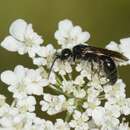en
names in breadcrumbs


The Tiphiidae (also known as the tiphiid wasps) are a family of large, solitary wasps whose larvae are parasitoids of various beetle larvae, especially those in the superfamily Scarabaeoidea. Until recently, this family contained several additional subfamilies, but multiple studies have independently confirmed that these comprise a separate lineage, and are now classified in the family Thynnidae.[1][2]
The females of some Brachycistidinae are wingless, and hunt ground-dwelling (fossorial) beetle larvae. The prey is paralysed with the female's sting, and an egg is lain on it so the wasp larva has a ready supply of food. As some of the ground-dwelling scarab species attacked by tiphiids are pests, some of these wasps are considered beneficial as biological control agents.
Tiphiid genera are classified as follows: [3][4][5]
The Tiphiidae (also known as the tiphiid wasps) are a family of large, solitary wasps whose larvae are parasitoids of various beetle larvae, especially those in the superfamily Scarabaeoidea. Until recently, this family contained several additional subfamilies, but multiple studies have independently confirmed that these comprise a separate lineage, and are now classified in the family Thynnidae.
The females of some Brachycistidinae are wingless, and hunt ground-dwelling (fossorial) beetle larvae. The prey is paralysed with the female's sting, and an egg is lain on it so the wasp larva has a ready supply of food. As some of the ground-dwelling scarab species attacked by tiphiids are pests, some of these wasps are considered beneficial as biological control agents.